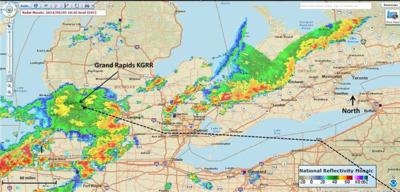Fri, Jul 08, 2016
Board Says Severe Turbulence Led To Loss Of Control Of An Expressjet Flight In September 2014 Near London, Ontario
The Transportation Safety Board of Canada (TSB) has released its investigation report (A14O0165) into the loss of control occurrence near London, Ontario, involving an ExpressJet Airlines flight. There were no reported injuries to the 3 crew members or 26 passengers, and the aircraft was not damaged.

According to the report, on September 5, 2014, an Embraer 145LR departed Grand Rapids, Michigan, destined for Newark Liberty International Airport, New Jersey. After departure, the aircraft deviated north of its intended track into Canadian airspace to avoid a line of thunderstorms, and climbed to its cruising altitude with the intention of navigating its way through them. The aircraft flew through a large thunderstorm that it could not avoid and encountered severe turbulence. The flight crew lost control of the aircraft and it descended rapidly, losing approximately 4000 feet, before they were able to regain control. The aircraft continued to its destination, where it landed safely.
The TSB investigation found that the flight crew anticipated that they would be able to navigate between thunderstorms. However, as the flight progressed, the line of thunderstorms intensified, and the intended route became obstructed. As well, the report observed that, during the loss of control, the flight crew momentarily applied flight control inputs that exacerbated the roll attitude of the aircraft. As a result, recovery time and altitude loss were increased. The investigation further found that when flight crews operate an aircraft outside of manufacturer recommendations and its limitations, there is a risk of compromising flight safety, resulting in injury to the occupants or damage to the aircraft.
Following this occurrence, ExpressJet Airlines improved dispatcher use of flight-following software, and developed policy and procedures related to adverse weather phenomena. ExpressJet Airlines also developed a training module for all ?ight crew members to promote severe weather avoidance and weather radar utilization techniques to identify developing storm activity.
(Source: TSB news release. Image from TSB report)
More News
Aero Linx: American Aviation Historical Society AAHS is dedicated to the preservation and dissemination of the rich heritage of American aviation. Our purpose is to collect, preser>[...]
CrewMember (UAS) A person assigned to perform an operational duty. A UAS crewmember includes the remote pilot in command, the person manipulating the controls, and visual observers>[...]
Immediately After The Right Main Tire Contacted The Runway Surface, The Right Main Landing Gear Failed On October 31, 2025, at about 1227 Pacific daylight time, a Maule M-7-235A, N>[...]
Also: IAE Acquires Diamond Trainers, Army Drones, FedEx Pilots Warning, DA62 MPP To Dresden Tech Uni The danger to the flight training industry and our future pilots is clear. Dona>[...]
"On December 3, 2025, at approximately 10:45 a.m., a Thunderbird pilot ejected safely from a F-16C Fighting Falcon aircraft during a training mission over controlled airspace in Ca>[...]
 ANN's Daily Aero-Linx (12.03.25)
ANN's Daily Aero-Linx (12.03.25) ANN's Daily Aero-Term (12.03.25): CrewMember (UAS)
ANN's Daily Aero-Term (12.03.25): CrewMember (UAS) NTSB Prelim: Maule M-7-235A
NTSB Prelim: Maule M-7-235A Airborne-Flight Training 12.04.25: Ldg Fee Danger, Av Mental Health, PC-7 MKX
Airborne-Flight Training 12.04.25: Ldg Fee Danger, Av Mental Health, PC-7 MKX Aero-News: Quote of the Day (12.04.25)
Aero-News: Quote of the Day (12.04.25)



